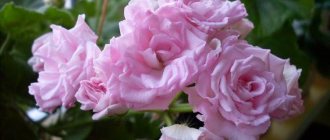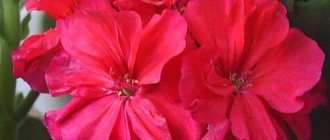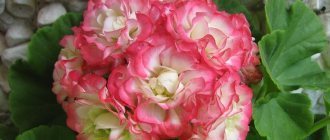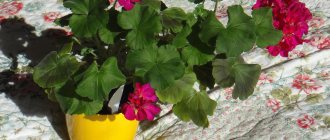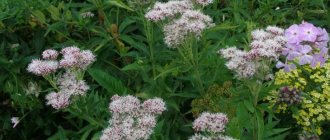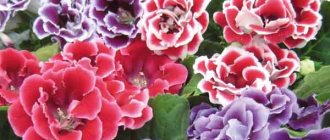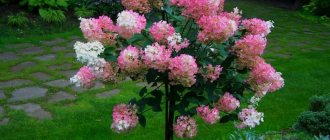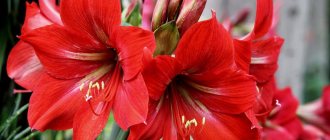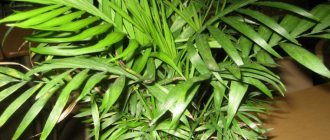What kind of flower is this?
Pelargonium is a herbaceous semi-shrub flower. There are already more than 400 varietal varieties around the world. The name comes from the shape of the fruit, which was similar to a crane's beak. The first species were identified in Africa. The pleasant smell and neatness have been loved since ancient times, and after that they began to appear in every home. Popularity arose due to active growth and unpretentious care. In warm climates, the plant lives in the garden, as the height can reach large sizes.
Names of species with descriptions and photos
There are a huge number of varieties of pelargoniums and the classification of some species is still unclear. Let's move on to the most famous plants that can be found in every person's home.
Orange
Orange pelargonium grows up to 35 cm in height. An unusual appearance with a peach cap on each bud and a greenish tint on the edge. With good care, 240 inflorescences change over 4 seasons. Provides a pleasant view from the balcony. Does not require special attention. Prefers semi-shaded areas. It should be watered abundantly, a little less in winter. In summer it is best to take it out into the fresh air. You can plant seeds in any weather.
Ice Rose
White ivy-leaved pelargonium. The foliage is medium sized, dark green. Compact plant. It does not grow quickly, but the buds of this variety are worth it. The flowers grow large, up to 6 cm, and are shaped like a rose. If you keep the plant in the sun a little, you can achieve a slight lilac tint.
Unique
It is different from all the others, because even the origin of this plant is still unclear. The species is not assigned to any classification, which is why it is called unique. Its foliage refers to dissected leaves. The aroma is piquant, without too much harshness. The small flowers look like a bird's feather. Plants can have either single or bicolor foliage. The variety is classified as tall. The peak of popularity of uniques took place at the end of the 19th century.
Iris confetti
Refers to zonal pelargonium. Their flowers are whitish with a pinkish tint in the middle. Foliage is small in size. In a pot it looks impressive and without unnecessary flaws. In the sun it takes on a brighter tone. And in winter it requires special care and feeding.
Mini Diana
Miniature golden leaf pelargonium. Belongs to the zonal group. Despite their small size, the flowers are large, white-pink in color and have a pleasant golden tint. The leaves are semi-double with a light green tint. Each leaf has a bright brown zone. Blooms at an accelerated pace. Not whimsical. In a small pot the flower looks compact and fluffy.
Diana Palmer
Zonal pelargonium. The petals are wavy with jagged edges in the shape of a carnation. Light shading. A spectacular bush, not fussy in flowering. Has a pastel orange tone. In order for a flower to sprout, it needs pruning. It bushes well, looks large and has grown. The leaves are compact. Inflorescences grow up to 5 cm. Quite a well-known variety. Mostly good flowering occurs in the summer. This plant needs feeding.
Natalie
Small semi-double species pelargonium. The first flowers are 4 cm in size. It grows in large caps. The bush is elegant, compact, but rather capricious. Not very tall. After pruning, it does not sprout immediately; most often it only replaces it. Responsive to temperature changes. The variety is tender. It has a peach color with a pale white edging of the petals. The trunk is almost always not leafy. Formation does not happen immediately. In hot weather it can throw leaves. The plant is worthy of attention for its dissimilarity.
Powder pouf
Small zonal pelargonium with salmon color. The lining of the petals is light, and the leaves themselves have a dark zone. Neat fluffy bush. The heat makes the cap white and thick, which creates a nice contrast. Shoots form quickly. Bright and pleasant to look at. There are almost always many buds present. The plant itself is small in size, which is why it will look perfect on the windowsill. Spraying is useful. Take it out onto the balcony only in hot weather. Dwarf variety.
Bornholm
A dense double flower in the form of an unopened rosebud. The petals of this plant are deep red. Each rose is 1 cm. In hot weather, the red color becomes a little paler, and in winter, on the contrary, it acquires a bright shade. The inflorescence is dense. Peduncles of medium height. Green sheets with a cream-colored mosaic pattern. Belong to the zonal type. It blooms in the shape of a cap. Over time it grows to medium size.
Albina
Pelargonium Albina grows quite quickly. After the cuttings have appeared, the peduncle rises on the 3rd day. However, the first flowering is not particularly abundant. 4 flowers grow on 1 peduncle. Large plant. It belongs to the zonal species and is considered a dwarf in height. The leaves are intense green. The flowers themselves are double, white with a small red stamen, and collected tightly. Due to the density of this species, the plant looks collected and neat. He loves feeding, so thanks to courtship, the flowers become larger. Suitable for beginners who take responsibility.
Elmset
Zonal variety of dwarf speckled pelargonium. Flower growers are attracted by the bright, golden-green leaves with creamy double flowers and red veins. The flower is decorated with light, bright crimson specks. Durable. With a neat shape, blooms profusely. The bush is well-fed and strong. Does not throw leaves, bushes on its own.
Dovepoint
A neat decorative border and a barely noticeable pink color, which echoes white, distinguish this plant variety from other terry types. The inflorescences are dense and delicate, voluminous compared to the dwarf type. In the sun, the bloom of dovepoint turns from white to pink. Peduncles are short.
Crown Princess Mary
Mary belongs to the double zonal pelargoniums. The inflorescences are tight, reminiscent of a rose. They grow up to 10 cm. The flowers themselves are white with a small green one in the center. When blooming, it may acquire a slight pinkish tint. The bush is fluffy. Blooms profusely in spring and summer. Should be replanted annually. Loves the sun and warmth. Tries to bloom even in low light. Prefers complex feeding. The name of this variety goes well with the name.
Princess Sandra
Terry pelargonium belongs to the zonal type. The flower is light red with a white section in the center. According to the type of growth, it is considered a standard pelargonium, which means it can grow quite large.
Passat
The double trade wind flower amazes with its light pinkish tint of ruffled petals. The density of this variety resembles a delicate fluffy pompom. The species is known among pelargonium lovers and beginners. The bushes require help in shaping , but with good care they bloom efficiently and abundantly. A sunny variety that will warm you even in cloudy weather. You can also see what this varietal flower looks like in the photo.
Peppermint twist
Terry pelargonium. Large flowers with a peachy-pinkish color, densely strewn with cherry speckles. The leaves are green with a brown zone in the center of the leaf. They retain their decorative appearance for a long time. Standard bush, blooms profusely. A bright variety for lovers of variegated plants.
Lake
The wavy petals of Pelargonium Laque are colored orange, and towards the edge of the flower they become completely white. The clearly colored color can only be seen in the sun. In the shadows the color fades. The plant belongs to the usual zonal variety, but in addition it requires careful formation. The leaves are elegant, thanks to the contrasting border of a brownish-green hue.
Bronze butterfly
In the center of the leaf there is a light shade in the shape of a butterfly , which, when basking in the sun, can give a bronze tint. The flower itself is large, peach-colored, and needle-shaped. The variety is not tall, the peduncles are short. Requires shaping. Bushes and blooms for quite a long time. Not afraid of rain and heat. Looks great on the balcony in summer. The size can be easily adjusted using a small flowerpot. Unpretentious, fast growing. It is the unusual leaves that make this species special.
Magnus
Terry zonal pelargonium plant. Flowers in the form of a red rose. The flower itself is bright and velvety. Blooms profusely and looks compact. The hat is round. The leaves are green, iridescent with a slight brown tint. In person it has a very bright colorful color.
Tsarskaya
In summer, you can see this type of plant in vegetable gardens, flower beds and balconies. It is distinguished by lush flowering and grace. Quite demanding to care for. It blooms for a short time, about 5 months. But if you see this plant even once, you will immediately want to bring it to your windowsill. Royal pelargonium grows up to 60 cm in height.
It differs from its colleagues by folded multi-colored leaves, dense leaf plate and jagged edges.
It can tolerate a little shade, but will bloom a little less luxuriantly. Prefers nutritious soil. You can add a little clay mixture to the soil. In cold weather, the temperature should not be lower than 12ºС.
Tamara
Tamara is many-sided and unique. The flowers are like dense pink and white marshmallows. The color is variable with pink veins and a border of the same color. The plant is tender and airy. Compact bush with small leaves. It blooms from infancy and never ceases to delight with the process. The petals are neat, with pointed tips.
Red
Sunny side required. The soil should be kept moist constantly, but in moderation. It is recommended to spray. Red pelargonium grows up to 30 cm in length. It should be placed on the balcony immediately after frost has passed.
It has a bright shade and universal resistance to all weather conditions. The variety branches well. There are huge inflorescences. The color of this type of pelargonium is similar to wine red. The leaves are classified as ivy-leaved. Grows quickly. Landing 30×30.
Maverick white-pink
The plant is 30 cm tall with good branching. White-pink color. The inflorescences are large. The leaves are green with a slight dark tint. Drought resistant. Preference is given to sunny places with fertile soil. You can start planting from the end of January. The depth for seeds is 0.5 cm. If you maintain a temperature of 20°C, then seedlings can be seen within a week.
Tuscany
Pelargonium is a non-double, ivy-leaved plant. Large caps and beautifully colored in a variety of shades. Blooms profusely, completely covered with inflorescences. There are two types of Tuscany that are currently popular.
Bernd
Bright flowers, opening wide, deep red. Each leaf is dark green with a bright brown ring. Classified as semi-double. The bush is harmonious, never stretched out. The lower part of the flower must be compacted tightly.
Hero
Large flowers of a crimson-red hue with white dots on the leaves. The bush is fluffy. It grows slowly, but branches very well. The leaves are medium-sized, dark green. The bush is low, the average height is up to 25 cm. The color is very rich. Does not require growth regulators.
apple blossom
Herbaceous plant with a fragrant aroma. The height of the bush is 25 cm. The leaves are round, green with a small red edge. The flowers are pink with a slight pallor in the form of a spherical inflorescence. The plant prefers light. For feeding, a turf mixture is chosen, and moderate moisture is preferred. If the flower is treated with love, the flowering will continue all summer. In the fall, a transplant and a bright place in the room are necessary. For seeds to germinate, the temperature must reach 20°C.
Black velvet
The difference between black velvet is in the unusual chocolate sheets, which create a wonderful combination with bright red inflorescences. If the bush is formed recently, then you will notice that at the initial stage there is a bronze coating on the sheets. The height of black velvet reaches about 40 cm. The shoots are strong. Loves light, but the sun's rays should not touch the petals.
Pelargonium is unpretentious, but this does not mean that it does not need care. Periodically you need to check the soil and water on time. Prefers mineral fertilizers. Sowing 1 cm. It is not recommended to allow the soil to dry out.
Indoor hybrids
The hybrid variety grows well at home. It looks like a large shrub up to 75 cm in height. Rounded green leaves. The flowers are umbellate up to 3 cm, come in multi-colored shades, namely: white, pink, red, purple. Flowering lasts six months.
The most popular pelargonium hybrids include two species.
Ardens
Rare hybrid plant. Wine red flower with a black stripe down the middle. This hybrid plant is easy to care for, but requires light. Moderate watering is required. An adult plant reaches a height of 20 cm.
Miss Stapleton
The plant never sleeps. This heart-shaped hybrid looks like a bouquet of pink roses. The stems are hard with stipules in the form of thorns.
Scarlet
Rosaceous pelargonium. The flowers are dense, double. The petals have two colors. The inside is like red wine and the outside is silver. The inflorescences are dense. The leaves are greenish, folded.
Madam
Madame Pelargonium has several varieties. Let's look at the main ones.
Bovary
Type of double zonal pelargonium. Fluffy bush. Blooms profusely. The flowers look like dark red wine , there are bright and large inflorescences. It is necessary to keep the soil moist and spray as often as possible.
Celeron
Graceful pelargonium with variegated leaves. The leaves are long-stemmed, gray-green with a wide cream edge. Has thin cuttings. Belong to the dwarf group. Blooms in bright pinkish color. The variety hardly blooms, but captivates with its beauty. The bush is compact and pleasant to look at.
Fisher appleblossom
Large flowers resembling a rose. The plant is white, with a rich white-pink border. Tight caps. The bush needs shaping. The leaves are green and have a dark zone. Requires special care.
Blue
Terry ivy-leaved pelargonium. The flowers have a similar blue-lilac hue. Compact bush. Needs a sunny area. Requires daily care. The plant needs additional minerals.
Miniature varieties
Miniature pelargoniums first appeared in England. The height of small pelargonium starts from 8 cm and ends at 15 cm. Ideal for the home, they can also be placed on balcony boxes. The leaves come in a variety of green shades. Pelargoniums are light and airy, but this is not their only advantage. They are compact. They can bloom in any decade.
Small plant species are currently divided into groups:
- Zonal.
- Ivy-leaved.
- Royal.
- Variegated.
- Succulents.
- Fragrant.
Most of the plants belong to the zonal species. The name was derived from the small zones on each leaf. Usually these are dark brown zones that are located in the center. It was thanks to breeders from England that small varieties of pelargonium appeared.
Among the most worthy breeders is Stanley Stringer. He was born in a small village called Okkold. He took up selection at the age of 50. The most popular variety grown is Alde, which can still be seen on shelves today. Varied
Deacons are also a dwarf variety of Stringer. Among them, the best are: tangerine and moonlight. The tangerine's flowers are orange-red in color, while the moonlight's are white-purple. The most impressive thing is that such a miniature plant has very large flowers.
One of its last cultivations is a golden goblet, which had a creamy hue and the petals were strewn with red dots. Stringer left behind about 160 varieties of pelargonium.
Ry Beatwell started his life as a postman. Therefore, it has a number of geographical names for varieties. Bitwell became famous for being able to develop a new type of pea variety. And they were covered with red, pink and purple specks.
Among the varieties with small spots, the most popular are: Milden, Semer and Elmsett. Milden has green-yellow leaves with bright white flowers flecked with pale pinkish. Semer is a dwarf species of pink flowers with red dots. Elmsett is a zonal species of pale pink flowers with red flecks. The latter species was named after Bidwell. The variety is decorated in wine color with green-red foliage.
And last but not least is the famous breeder Brian West. West is famous for developing a variety whose leaves resemble stars, which is why the variety is called star-shaped. The varieties have spread throughout the world. Even despite their unusual shape and the fact that they do not exactly resemble pelargoniums, they can be cared for in the same way as ordinary varieties.
In recent years, Vesta has seen the birth of miniature plants up to 8 cm. The varieties were named anni popham.
Features of cultivation
Silk Moira, Sharon, Madame Celeron, Dylan Sharon, Diana Louise, Carousel, Claydon, Elnaryds, Flaming - all these varieties deserve the attention of every domestic gardener. It is not difficult to provide proper care for them. First of all, make sure that the plant is constantly fed with sunlight: in low light, the petals and leaves of the specimen become dull. However, on hot summer days, try to shade your geranium. It is undesirable for pelargonium to overheat.
As for watering, it should be regular: in summer, moisten the substrate every other day, and in winter at least once a week.
Rules of care
Plants require special care and pelargonium is no exception. Usually the flower is located in the room, and begins to bloom profusely in the summer. In winter, it is necessary to ensure a temperature of at least 15 °C and avoid waterlogging of the soil. It is best to leave the plant on the sunny side, but only where there are no drafts.
Pruning is carried out after flowering - in autumn. But if the roots have grown well, an exception is made. It is recommended to transplant in February. For pruning, you need to leave shoots of about 10 cm. Do not forget about fertilizing for each flower.
Plants can lose their compactness if they are not given proper care.
After pruning, the cuttings should be left for 2 hours in a dry room with fresh air. After pruning, cover them with plastic bags to help them take root. For pelargonium to grow, a temperature of at least 20 °C is required.
In addition to beauty, pelargoniums also have medicinal qualities for people. After all, they contain an extract that cures respiratory tract infections. In addition, the oil of this plant has a calming effect. But the main thing is that the flower goes well with any landscape in the house and allows every housewife to feel like a woman.
dacha.expert
Flower passion.
I love all living plants. I see a highlight in each of them. But my strongest flower passion in recent years has been pelargoniums.
Dear readers, at the moment I have a small but amazingly beautiful collection of unusually blooming pelargoniums. I have “Rosebud” - pelargoniums blooming with roses, Tulip - blooming with tulips, asters, carnations, one variety - peonies. There are several fragrant varieties, with the scent of rose, lemon, wormwood, peach, and apple. And I want to share all this wealth with you.
Terms of sale of pelargoniums 2022
Sales all year round, subject to delivery by a transport company, by bus, I arrange it myself. To the order amount you need to add approximately 400 rubles for transportation and packaging. I don’t send pelargoniums by mail because they don’t arrive well, then they get sick for a long time and, as a rule, they don’t survive.
My email address
Viber and WhatsApp tel.
Apple Blossom Rosebud is a rosaceous zonal pelargonium. The plant is very large and fast growing. It requires the initial formation of the bush, and then it will show all the beauty and harmony of flowering. Loves very “fat” soil. Last year I fed them with liquid fertilizers for the flowering ones, but this year I just planted them in “humus” in the spring. The variety blooms very profusely, begins early in the spring and, probably, if not pruned in the fall, will bloom into the winter. This photo is fresh from autumn, I published it only because of its good quality, it does not reflect the true beauty of the variety. In summer the hats are much larger and denser. I especially admire roses - large white ones with a green center and pink edging of delicate petals.
.
anykadevyshki.ru
Natalia, I liked Stellar too :). I was about to send it to the flowerbed in the summer, but I realized that I didn’t want to be left without it and still grabbed the cuttings :). Now I'm glad he survived, he's a good breed. Sometimes you get tired of heavy double inflorescences and want simplicity, grace and clean lines. This is Monique Mc Ewan for my taste :).
forum.pelargonium-club.ru
Eric hoskins pelargonium description
Only my sister Vera and I accept orders! We have no intermediaries! By mail from 3 cuttings. Fresh list of rooted cuttings. Achievement - 400 rub. Aina - 400 rub. Expand text... Ainsdale Duke - 400 rub. Alex Kitson — 350 rub. Apple Blossom Rosebud — 300 rub. Asarnas Asgard — 300 rub. Blekinge - 350 rub. Bold Carmine — 250 rub. Bold Magic — 350 rub. reservation! Bornholmpelargon - 300 rub. Brocade - 350 rub. Bronze Butterfly (stellar) — 250 rub. Brookside Polka — 300 rub. Clatterbridge - 350 rub. Dagmar Murray - 400 rub. Deacon Moonlight -250 rub. Dick Key — 400 rub. Dolce Vita — 300 rub. Edwards Courtney - 400 rub. Ekeby Lovisa — 250 rub. Elmfield (stellar) - 300 rub. Elnaryds Karin — 350 rub. B. ck Phillips - 350 rub. Jim Haughton - 400 rub. Jip's Freda Burges (variegated leaf) - 500 rub. Joan Hall - 350 rub. Just Bella - 300 rub. Just Beth - 300 rub. Karen - 300 rub. Lara Delight — 500 rub. (teenager) Lara Harmony - 450 rub. Lara Mandarin (Zonartic) — 1500 rub. Lilian Andrea (tulip) - 700 rub. Lullaby - 350 rub. Magnus - 250 rub. Malaika (ivy) - 300 rub. Marbacka Tulpan (tulip) - 500 rub. Marmaris — 250 rub. Maureen - 250 rub. Mme Recamier - 300 rub. Mrs. Salter Bevis (cactus-flowered) - 250 rubles. Newport - 350 rub. Occold Lagoon (Belgium) — 250 rub. Odensjö Jolin — 300 rub. Odensjo Liesel - 300 rub. Odensjö Rodluvan — 250 rub. Odensjo Sofie Arden - 300 rub. Odensjö Trish — 300 rub. Okka (ivy) - 250 rub. Orange Bud - 350 rub. Orangesonne - 300 rub. PAC Lavender (ivy) - 250 rub. he! PAC Lauretta — 300 rub. PAC Rhodonit (ivy) - 250 rub. PAC Salmon Queen — 350 rub. PAC Vicky (ivy) - 250 rub. Reservation! Pensby - 300 rub. Picotee Pink — 350 rub. Red Rambler - 250 rub. Rose of Amsterdam — 300 rub. Royal black rose (ivy) - 350 rub. Royal Purple — 350 rub. Rushmoor Golden Girl (stellar) — 350 rub. Sister Henry - 300 rub. Shan Hoy - 400 rub. Shirley Anne - 250 rub. Sophie Marion - 350 rub. Sundborn - 300 rub. Sutarves Klara San — 300 rub. Swanland Pink-Australien Pink Rosebud — 300 rub. Trumphs - 300 rub. Vectis Rosebud — 300 rub. Wendy Read - 350 rub. Reservation! Wantirna - 250 rub. Wedding Royale - 400 rub. W. Tora - 300 rub. Yves-Csardas - 400 rubles. Reservation! Silk Aurora - 400 rub.
- Pelargonium (geranium)
- Rosebuds
- Dushistik
- Zonal
- Zonartik
- Ivy-leaved
- Sadovaya
- Stellars (cloves)
- Tulip-shaped
- Astilbe
- Heuchera
- Delphinium
- Irises
- Daylilies
- Lilies
- Peonies
- Roses
- Phloxes
- Hosts
- Echinocea
- Clematis
- Calistegia
Pelargonium April Snow
One of the followers of the Appleblossom Rosebud variety can be considered the dwarf pelargonium April Snow with double airy flowers in the shape of roses. The color of the flowers is white, but like the previous variety, the edges of the graceful petals are decorated with a soft pink stripe, and the central part of the corolla has a slight greenish tint.
The leaves of zonal pelargonium are bright, green, with an indistinct brownish zone. The creators of this variety tried to please those gardeners who could not afford to grow large Appleblossom Rosebud bushes, but April Snow will comfortably fit on the narrowest window sill in a city apartment.
Pelargonium PAC Viva Rosita
Rosaceous, very spectacular pelargonium PAC Viva Rosita is rightfully one of the most popular varieties of recent years. The uniqueness of the stocky plants, which readily produce lateral stems, is their ability to bloom long and profusely, forming inflorescences of 15–20 double flowers. The peduncles are strong and hold well such a number of multi-layered flowers, reminiscent of ancient park roses. The diameter of a single flower can reach 6 cm, while the inflorescences are loose, and you can easily see each miniature red-raspberry rose. Look also at the photo of Garden Tradescantia!
As soon as the bush begins to grow flower stalks, it urgently needs regular watering and fertilization, otherwise the loss of some buds cannot be avoided. Despite the apparent capriciousness shown in the photo, the pelargonium variety overwinters well and will be a welcome gift for any person who is partial to indoor floriculture.
Appearance Features
The variety is distinguished by its most beautiful variegated foliage: the bright green center is often surrounded by a white and yellow border, revealing a burgundy tint in the sun. In addition, the foliage has a border of two or three stripes, highlighted on the leaf with cream, yellow, brown, and golden colors. The inflorescences are small, simple in shape with bright flowers.
The genus stands out for its calm growth and good branching, and is wonderfully suitable as a detail in the interior due to its unique decorative leaves.
Attention! The most unpretentious geraniums are considered to be varieties with golden and gold-black leaves. They are considered the most hardy, they tolerate wintering and direct sunlight well.
Description of the plant
Pelargonium is a perennial plant belonging to the Geranium family , which includes more than 250 species and a huge number of varieties. Among this diversity there are both subshrub and herbaceous varieties, with straight, branched or creeping stems.
Flowers are collected in umbels or corymbs. Particularly decorative varieties are distinguished by huge round double flower caps. The leaves are carved, palmate or palmately dissected.
The color of the foliage, depending on the variety, varies from light green to dark green.
- Pelargonium is characterized by a strong odor from the leaves. Its intensity differs depending on the variety. Varieties with a pronounced smell of chocolate, citrus, and perfume have been developed.
- The plant is light-loving.
- Easy to care for. Quickly adapts to growing conditions.
- Tolerates lack of moisture well.
- When grown in open ground, the plant should be moved indoors for the winter.
- Easily propagated by cuttings.
Features of care
- Trimming.
- Watering.
- Temperature.
The right time for the formation of variegated geraniums is spring . Autumn circumcision is poorly tolerated. Thanks to this procedure, wintering can be facilitated, the appearance of young shoots and lateral shoots can be formed, and the number of inflorescences can be increased. The plant that has grown during sleep is pruned again in the spring.
Important! From mid-autumn, geraniums begin a dormant period and development stops.
On hot days, constant watering is necessary, but it is important to ensure that the water does not stagnate. Pots must have drainage holes; they help drain excess water. Spraying and washing the leaves is strictly prohibited; this harms the plant. Water should be at the root or in a tray.
Do not forget that geraniums need winter rest . The suitable temperature for this is 10°C. If you do not maintain the correct temperature during this period, you may not expect buds. If you find a darkened edge of a leaf in winter, immediately remove it from the window, this is a warning that the temperature is too low.
During the flowering period, the temperature is approximately 20-23 degrees. In free outdoor space he feels comfortable even in the sun.
Bloom
Pelargonium Odensjo Symfonia - description
Pelargonium generally blooms from spring to late summer. The dormant period lasts from autumn until the end of winter.
For reference! There are methods that help prolong flowering, but it is not advisable to use them, as they deplete the plant.
Periods
During rest, reduce daylight hours to 12-13 hours, water pelargonium a little less often and lower the air temperature. During the same period, the plant is pruned. You cannot replant a flower and fertilize it.
By spring, daylight hours and the amount of watering are gradually increased. In March, regular care for pelargonium begins. At the same time, the first fertilizing is applied and, if necessary, replanted.
In September, the plant begins to prepare for the dormant period. Reduce the number of waterings and the length of daylight hours.
Features of flowers
All zonal pelargoniums can be divided into three groups - non-double, semi-double, double. It all depends on how many petals the flower has. Specimens with eight or more petals look most beautiful.
Often the owner does not know the name of the variety and is guided only by the flowering characteristics
There is another classification, which is based on the structure of the inflorescences. They can look like roses, tulips, carnations, stars.
Separately, there are varieties that bloom like cacti.
Pelargonium Richard Hodgson
Compact bushes of star-shaped zonal pelargonium Richard Hodgson are loved by many lovers of indoor plants, while the variety, according to gardeners, has absorbed the best features of both star-shaped and classic plants.
The bushes do not require painstaking care and shaping; the plant independently produces side shoots and maintains good shape. Even without inflorescences, the bushes look attractive thanks to the “petal” characteristic of stellars, with a dark contrasting zone in the middle of the leaf blade. But when flower stalks appear, the plant shows all its charm.
The flowers of this pelargonium variety, as in the photo, have a complex color. On a white or pinkish background, which becomes more saturated towards the tips of the petals, bright stripes, specks or very large areas of red or carmine color are clearly visible. At the same time, like all stellars, the petals of Richard Hodgson are jagged. The corolla is very airy, terry with noticeable red stamens.
Diseases and pests
People do not always know what this or that symptom in a plant means. Leaves may wither, turn yellow or dry out due to improper care or disease.
- When overwatered, gray spots appear on pelargonium - this is a sign of gray rot. Damaged parts are removed and the plant is replanted.
- If the branches are constantly stretched and flower stalks do not appear, then this indicates a lack of light. It is necessary to trim the pelargonium and place it in a lighted place.
- Reddening of the leaves occurs at low temperatures. In this case, you need to trim off the damaged areas and move the pot to a warm place.
Pelargonium can be infected by pests. When the air is dry, plants are attacked by spider mites. It can be easily identified by the fact that the leaves begin to dry out and cobwebs appear on the branches. To get rid of this pest, you need to treat all plants with the Aktara insecticide.
Mealybugs can be detected by a characteristic white coating on the leaves. Pelargonium is carefully washed, removing stains, and the soil is spilled with Aktara, then the entire green mass is sprayed. It is important to review the conditions for keeping geraniums and avoid over-moistening the soil.
The tiny white butterflies are whiteflies. You can get rid of it with the help of insecticides. Three times a week you need to water the soil with a diluted preparation. This treatment lasts for a long time.
Zonal pelargoniums are distinguished not only by the unusual color of their flowers, but also by their beautiful leaves. With proper care, the plant will bloom for up to six months.
Pelargonium Gosbrook Robyn Louise
Dwarf pelargonium Gosbrook Robyn Louise is a wonderful choice for the home. Small neat bushes of this variety of pelargonium, as in the photo, bloom profusely and can decorate any windowsill.
The plant does not have a high growth rate, does not strive to grow upward, the shoots form a dense spreading crown. The leaves of this variety of pelargonium, like those of other stellars, are seriously different from the rounded foliage of classic zonal varieties. But this only adds charm to the bushes until double pink and lilac flowers appear above them. A characteristic feature of the corollas is their concave petals, reminiscent of a tiny boat.
Varieties
On store shelves today you can find 2 varieties of seeds of this species.
- Common pelargonium. This is the flower that is most often confused with geranium. They both have a specific aroma, their leaves and flowers are very similar to each other. The flower is grown exclusively indoors - in rooms, greenhouses or warm glazed balconies.
- Hybrid pelargonium. This variety appeared relatively recently. This flower differs from its predecessor in taller and more powerful stems, as well as more lush and voluminous inflorescences. In addition, the color of the flowers themselves of such a hybrid pelargonium can be absolutely anything, and the color palette is much more diverse.
Let’s talk about the most striking representative of such a hybrid plant, the intricacies of its cultivation and the choice of seed material.
Where is the best place to plant and how?
Ideal soil
You can plant them in ready-made store-bought mixtures with neutral soil acidity.
If you don’t trust store-bought ingredients, you can prepare the mixture at home. You will need two parts:
- turf land;
- sheet;
- distillation.
All this needs to be mixed with a small amount of coarse sand. Drainage and a thin layer of soil are poured into the pot, on which the flower is planted along with the soil, sprinkling the roots with new soil.
Reference! Geranium does not perceive transplantation very positively. From time to time it is strongly recommended to loosen the soil so that oxygen reaches the roots.
During budding, it is necessary to intensively fertilize the transplanted flower . Using complex feeding once a week will be sufficient. Compost can be combined with irrigation by diluting it with water. Such a tandem will ensure access of nutrients to the roots. It should be replanted in early spring.
Location and lighting
Experienced flower growers advise placing the beauty near a south window.
When growing pelargonium on the balcony, you can transfer it there in April. If you want to send a flower to the garden, wait until the air and soil warm up to the proper temperature.
During the cold period, place geraniums on the warmest and brightest windowsills . She is not afraid of sunlight. Increased lighting is good for her. But on the days of the warm season, leaving the geranium on the window, it is necessary to shade the crop from the rays.
6 Propagation by seeds
The seed method of propagating ampelous pelargonium is quite labor-intensive and requires experience and patience. But if it is not possible to get cuttings of climbing geranium, but you want to grow a spectacular specimen at home, you should try to get the crop from seeds.
When propagating ivy-leaved pelargonium from seeds, you need to be prepared for the fact that the resulting plant will not fully correspond to the varietal description: the shape and color of the petals may differ radically. This is especially noticeable when growing hybrid varieties with double buds. In order not to be disappointed, seed material should be purchased from companies that are professionally engaged in the cultivation of flower crops and have proven themselves well in this field.
To germinate seeds, you can use soil of the same composition as for planting adult plants, adding pieces of sphagnum moss:
- moisten the soil generously with a spray bottle;
- deepen the seeds by 0.5-1.0 cm;
- cover the container with film or glass;
- ventilate daily, removing the glass for 10-15 minutes, and remove condensation;
- Place the box with seeds in a warm (+22...25°C) and well-lit place, and in the winter months, supplement it with phytolamps so that the total daylight hours are at least 12 hours.
Under favorable conditions, the first shoots will appear within 10 days, and after a month, young seedlings can be picked and transplanted to a permanent place.
Unpretentious pelargonium
This flower certainly cannot be called rare, but this does not make it any less beloved.
So, unpretentious and charming pelargonium. I grew my first pelargoniums in 2013 from seeds, then bought seeds of interesting varieties several more times (in 2016 and 2021). I pinched off one copy in my eldest son’s kindergarten, one was given to me, and my latest purchase is a cutting of red rosebud pelargonium from a flowerbed near my mother’s house.
Description of the plant
With proper care, pelargonium forms a lush and abundantly flowering bush 30-60 cm high. Pelargonium has a thick stem and rounded leaves with different color options.
The central stem is thick but breaks easily. Tested by cats and children
The shape and color of the flowers themselves are also varied.
This is the 'Black Velvet' variety, grown from seeds in 2016. I was attracted by the color of the leaves, but the flowers are also very beautiful!
Growing conditions
I will briefly outline the preferences of my beauties.
Pelargonium loves:
- Moderate air temperature
- Good lighting
- Pinch
Pelargonium does not like:
- Soil overflow and water stagnation
- Excess fertilizer in the soil
- Draft
Ads by
Planting, transplanting and propagation
Pelargonium propagates by seeds and cuttings.
Both methods are quite simple and will not cause any difficulties. I place the seeds at a short distance from each other
Grown pelargonium seedlings
For the first time, when two true leaves grow, I plant them in small 200 ml cups, and only then after one and a half to two months I transplant them into pots.
Grown-up pelargoniums are ready to get their own personal pots :)
This is a pelargonium variety 'Ripple', height 50 cm. The petals are decorated with bright strokes. Grown from seeds in 2013
Another method of propagation is cuttings. And here it is necessary to take into account a number of nuances (well, at least I pay attention to this):
- For cuttings, I select faded apical shoots that have two or three pairs of leaves.
- I cut under the internode.
Cuttings can be rooted in water or planted directly in the ground:
- When rooting in the ground, I use light and breathable soil with the addition of coarse sand.
- When rooting in water, I add activated carbon.
This pelargonium grew from a small cutting that I cut in early September.
Photo taken on November 12 I replant pelargoniums once a year. The new pot should be 2-3 cm wider and 2 cm deeper than the old pot. I choose a light soil, with a small peat content, or I prepare it myself: I mix garden soil with coarse sand.
Before transplanting/planting, I remove all faded buds and yellow leaves. Since pelargoniums are susceptible to fungal diseases, it is advisable to take pots with drainage holes or provide a drainage layer (I use expanded clay and crushed stone), and also add small pieces of charcoal (an excellent antiseptic).
Pelargonium with snow-white flowers
Watering and fertilizing
In relation to pelargonium, the following phrase is quite suitable: “Less is better.”
It is better to underwater/underfeed this flower than vice versa. I water it with warm water as the soil dries; pelargonium is very sensitive to excess moisture in the soil. After transplanting into a new pot, I start feeding it a month and a half later, using a fertilizer solution in a minimum concentration. I fertilize once a month, with the exception of the winter dormancy period. Another pelargonium, a birthday gift. They said that this is an ampelous look
Features of cultivation
This is an absolutely problem-free flower; I have pots of it on my western and eastern windows and feel great.
Care consists of watering and fertilizing and obligatory pinching to get a beautiful bush. Well, where would we be without red pelargonium :), bright and rich color
But my husband can’t stand pelargonium, because even the zonal species manage to smell a stunning smell :). Therefore, almost all of my pelargos grow in the office (the conventional name for the room where the computer and my handicraft supplies are located) - he rarely goes there. Oh, he doesn’t know that I have my eye on fragrant pelargoniums!
Thank you for your attention!
Pelargonium Bronze Butterfly
Another spectacular stellar is the Bronze Butterfly pelargonium, characterized by bright inflorescences of salmon-colored star-shaped flowers and decorative leaves with a dark figured zone in the center of the leaf blade.
Star pelargoniums, including this interesting variety, cannot be confused with plants that produce double flowers, nor with rosaceous or tulip-shaped varieties. The shape of the corolla in this case is closest to that of a clove. Semi-double flowers consist of feathery, salmon-colored petals dissected along the edge.
The plant will produce the greatest effect when planted in a flowerbed in a well-lit place, carefully cared for and pruned.

